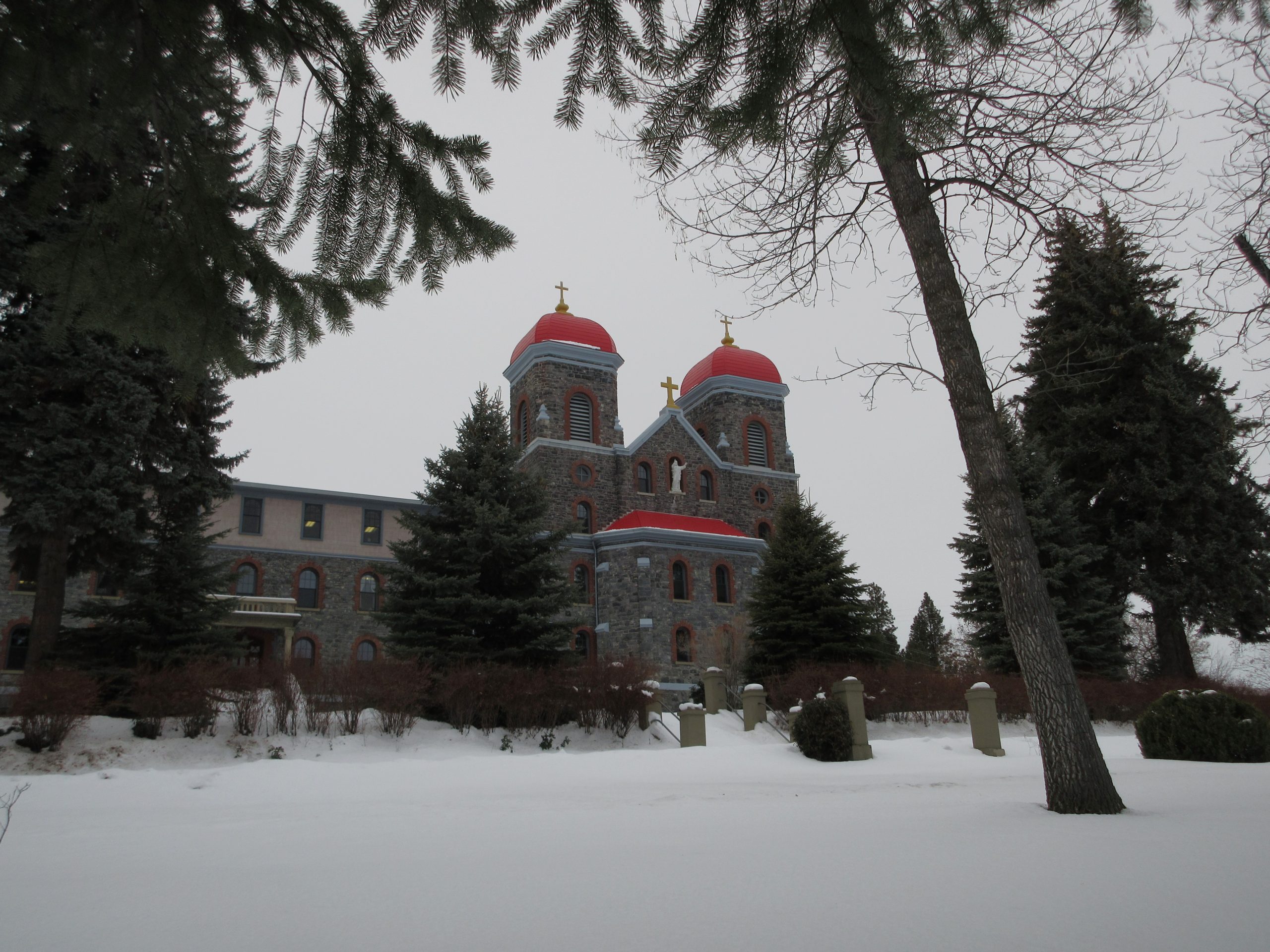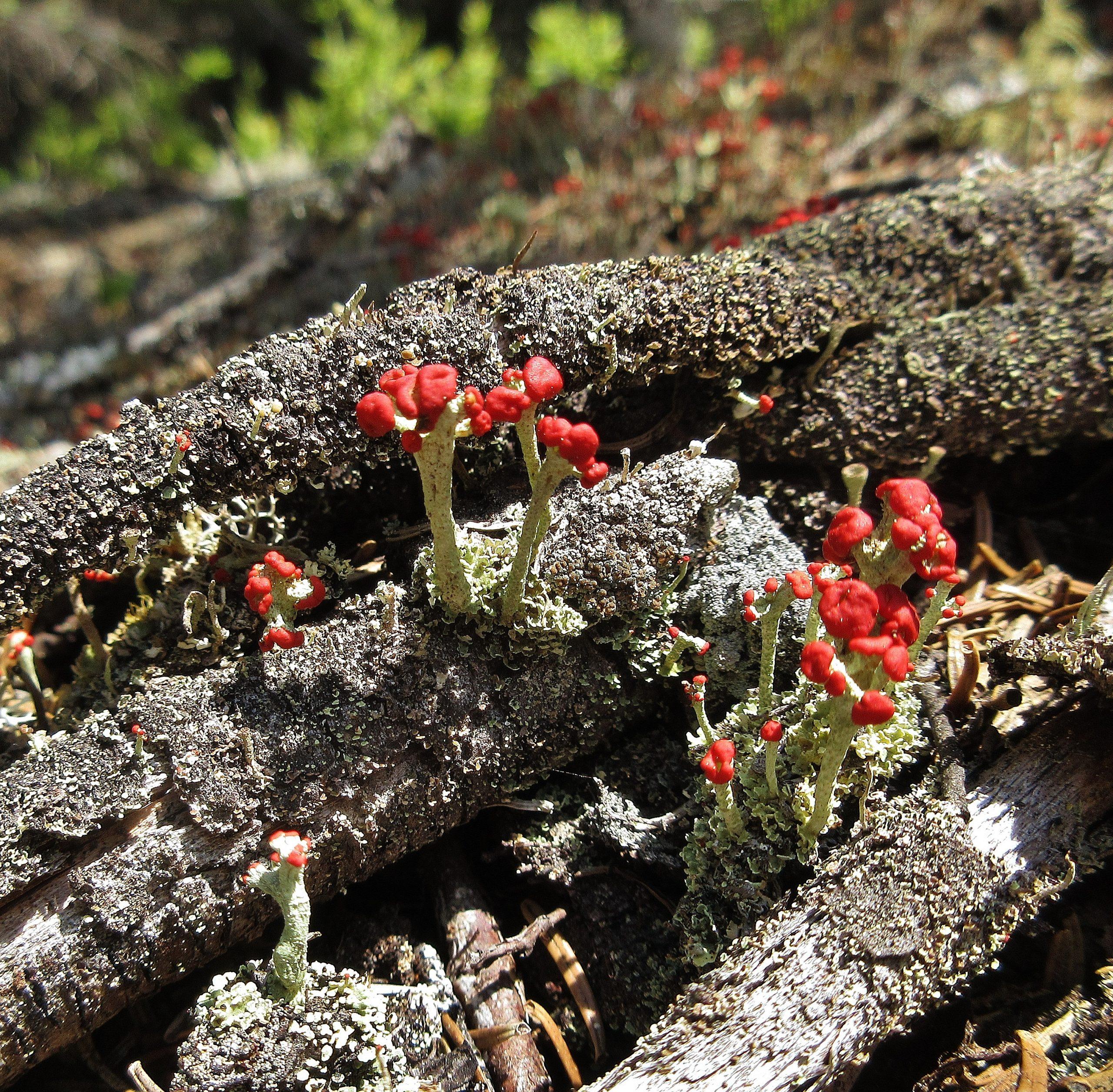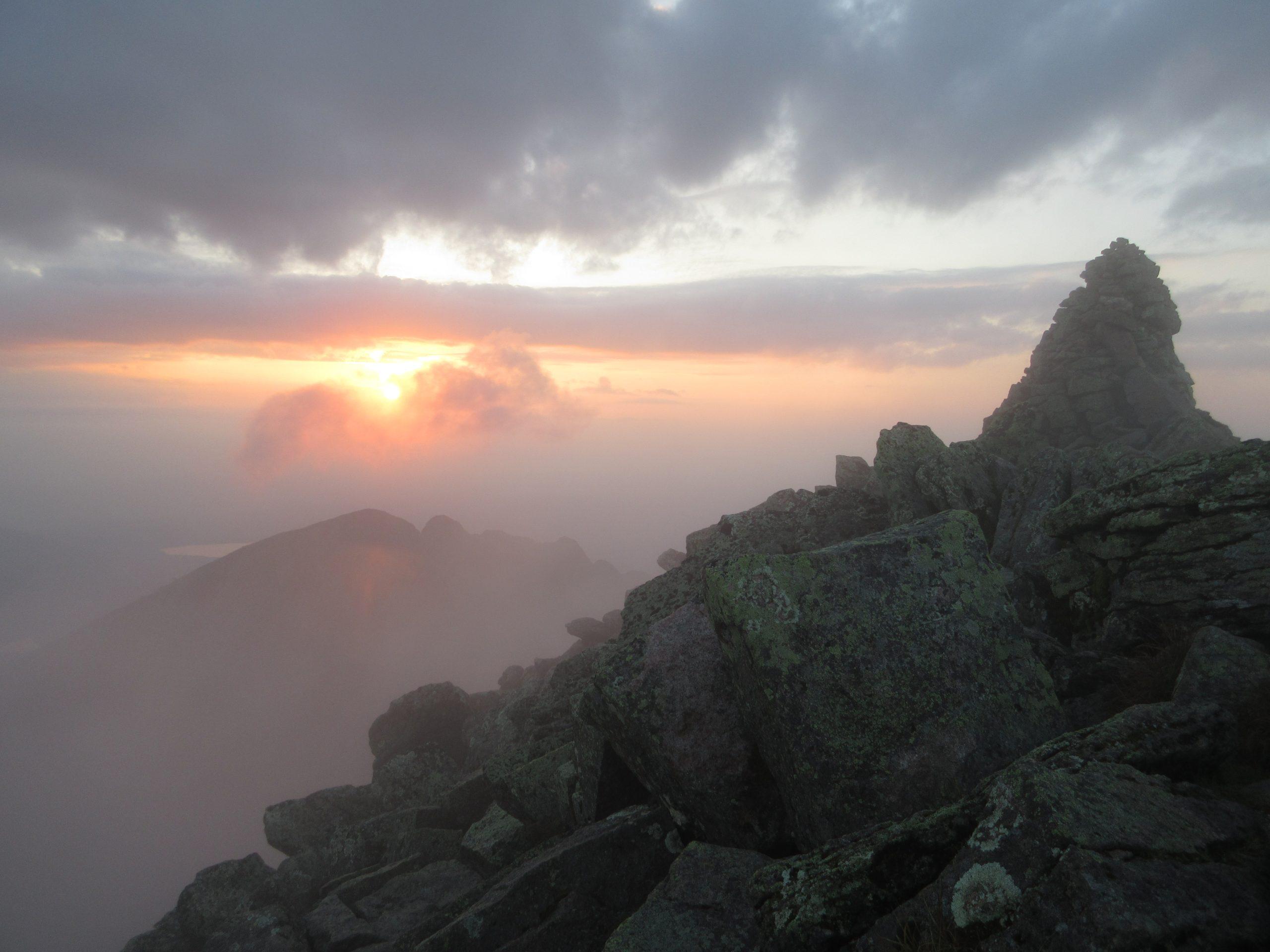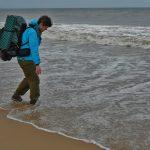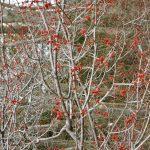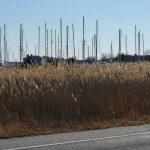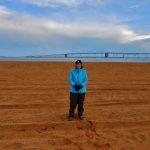As the calendar turned to mid-March, I watched weather predictions closely. I knew that sometime over the next few weeks, mud season would arrive.
For anyone living deep in the Maine Woods, mud season is the most challenging time of year. Travel ranges from difficult to impossible. Water access routes are closed: the remaining ice atop ponds and lakes prevents boating, but the ice is no longer safe for snowshoeing, skiing, or snowmobiling. Trails are a messy mixture of slushy snow, ice, and mud. Unpaved woods roads become quagmires that will swallow the tires of anyone foolish enough to attempt driving over them. (A tip for the uninitiated: if you see masses of frog eggs floating in puddles in the road ahead of you, you should probably turn back before you get stuck.)
I made one trip to town in February to buy food, pick up mail, and do errands. My plan was to delay my March trip as long as possible, and to get enough supplies to see me through the entire month of April, if need be. If I went to town too soon, I could be facing a long stretch with a limited diet, in which my perishable foods had either all been eaten, or lived up to their name and perished. But if I waited too long, mud season could trap me.
March 15 was very wintry. At the closest National Weather Service station, 16 miles away, the high temperature for the day, with wind chill factored in, was minus 12 Fahrenheit. (No, that’s not a typo: minus 12 with wind chill was the day’s high; the low with wind chill was minus 26.) But that evening, when I looked at the long-range forecast, I saw that a heat wave was on its way. Starting on the 21st, and for several days thereafter, highs were supposed to reach the forties or fifties.
I felt a sense of urgency. Because I would be pulling unusually heavy loads on my gear sled, I wanted to travel across the flat, low-friction ice of First Roach Pond, rather than pulling my sled up and down trails through the woods. With the coming warmth, how much longer would the ice be safe for me to cross? As the week wore on, I kept an eye on the forecast, and I emailed Eric Stirling of West Branch Pond Camps for advice. At seven and a half miles from my cabin, he and his family are among my closest winter neighbors, and he’s been a generous and patient mentor in all things related to off-grid living.
I was relieved when Eric replied that, based on his past experience, the ice should remain safe through the following week. But he cautioned: “The big thing to watch for will be openings near the shore. Also, a big rain storm would really raise the water and make it unsafe to get out on the ice. Be careful!”
Rain was predicted for March 26, so it seemed my deadline for getting my supplies across the ice was March 25. On the 22nd, I loaded my gear sled with accumulated trash, recyclables, and laundry. I strapped on my snowshoes, buckled into my sled’s harness, and set out from shore toward the public boat launch on the opposite side, about two and a half miles away. I crammed a month’s worth of errands and visits with in-town friends into the ensuing two days. On the afternoon of the 25th, I was back at the boat launch.
I had a can with four and a half gallons of gasoline for my generator; a duffel filled with clean laundry as well as supplies such as lamp oil and batteries; plus another very large duffel bulging with food. The latter bag was so heavy I could barely lift it. I knew I would need to make two trips across the ice to get everything across. I left my belongings at the boat launch as I drove my car to the nearest parking spot, about a mile and a half up the gravel road, and walked back. All told, I would be walking nine miles, five of them pulling a weighty load.
As I prepared to set out across the pond, local game warden Joshua Polland stopped to talk. Though he agreed the ice should be okay, he offered to check its depth along the shoreline, where sun-heated rocks had caused some melting. He reported that it was still about a foot thick. I needed only four inches, so all was well.
I was pleased to find that my sled slid smoothly across the pond’s surface despite its burden. Slush had accumulated atop the ice, and as water sloshed into my boots, I was grateful for wool socks that kept my feet warm. Back at my cabin, I unloaded my sled, changed into dry socks, and sent quick messages to a friend in town and Warden Polland to confirm that my passage had gone well. I hurried back across the ice for my second load, and set out for my final crossing about sunset.
I had thought of this last leg of my trek as a slog to be endured. But as often happens in my life in the woods, transcendent moments along the way repaid me for my effort. As darkness fell, a close-to-full moon gleamed above the fringe of shoreline trees to my right. To my left was the white plain of the pond. Mist was streaming in, obscuring the horizon, swallowing mountains into a gray void. Ahead of me, golden lamplight shone from my cabin windows, guiding me home. I had the sense I was passing through a dimensional gateway, from the busy conventional world into a quieter realm where time flows more gently. I reached my shore just as the advancing mist threatened to engulf me, secure in the knowledge that I was well supplied for coming weeks of solitude.
Since then, the weather has remained in mud season range, sometimes above freezing, sometimes a bit below, with precipitation falling either as cold rain, or as wet snow that doesn’t accumulate much or linger long. The snow depth this winter was less than usual. An unseasonable rainstorm at Christmas erased December’s snowpack, and January started with bare ground. Now much of my ground is bare again, though patches of snow remain. Of course, temperatures may drop, and significant snow is still possible in April. Time will tell.
I’ve been surprised when people seem to expect that I’ll be delighted by a mild winter and early arrival of spring. On the contrary, my love of cold and snow – with the austere beauty they yield – is a major reason I chose to move to the Maine Woods. The attenuation of our winters saddens me.
I know that New England weather has always been variable, and that, even a century ago, some winters were milder than others. But I can’t help worrying over each new winter that is shorter or less frigid than usual, thinking of it as another potential data point in our region’s warming trend – which is, of course, in keeping with more widespread global changes. Data from the U.S. Geological Survey show a clear trend toward decreasing winter ice thickness, as measured on a local river (the Piscataquis). They also show a trend toward earlier melting of ice on lakes in northern and western Maine, including nearby Moosehead Lake. (I’ll be happy to send summaries of these two studies to anyone who is interested.) If these trends continue, our forests and wildlife will change along with the climate. The Maine Woods I know and love may look and feel very different to future generations.
On a more immediate, practical level, the advent of mud season has made my daily life at camp harder. For one thing, I rely on sustained cold to keep my meat and dairy products from spoiling.
And for another, it’s more challenging to get around. When it’s consistently cold, I can make solid paths of firm, dry snow, on which I walk easily to my outhouse and pump. Following each storm, I put on my snowshoes and walk back and forth a few times, packing down the snow under my feet. After that, no snowshoes are necessary. But warm weather destabilizes those paths.
On a surprisingly balmy day in mid-March, I was dismayed by my struggle to carry full, heavy pails of water from my pump to my cabin. I kept slipping off my hard-packed path into the softer snow to either side. At unpredictable intervals, one leg would break through the path itself and sink downward. When that happened, I was thrown off balance, the weight of the pails wrenched my arms, water spilled, and I sometimes ended up on my knees. The chore took much longer than usual.
That evening, when I checked my email, I found a message from a colleague that concluded with a cheery “Hope you’re enjoying the mild weather.” I had to remind myself, as I composed my reply, that she really did mean well. Until the ground is completely bare, getting my water will remain awkward.
Which brings me to a topic I’ve been promising to discuss: water. As I mentioned in an earlier post (https://www.wendyweiger.com/daily-life-off-the-grid-fire-and-water/), fire and water are the two basic needs around which my daily life revolves. If you’ve read that post, you’re already well acquainted with my woodstove. Let me introduce you to my other trusty backwoods helper: my pump.

My pump is nearly three hundred feet from my cabin. The ground nearer to my cabin was too soft to support the heavy equipment needed to drill my well. On one level, I would prefer to have the pump closer, but on another, I appreciate the exercise the extra distance gives me.
As primitive as this method of accessing water may seem to city folk, my pump incorporates a modern technological innovation that makes my cold-weather life much easier. When I’m done pumping, the water drops below the frost line, so it never freezes. Even when the temperature is below zero Fahrenheit, liquid water flows from the spout after a few strokes of the handle.
My two stainless-steel pails were intended for use in milking cows. I ordered them from Lehman’s, a self-described “low tech superstore” in Ohio. Its founder, Jay Lehman, wanted to offer products that would enable the local Amish to preserve their way of life. Today, Lehman’s is a good resource for anyone living off the grid.
It takes nearly fifty strokes to fill my pails, and they weigh almost fifty pounds when full. Filling and hauling them provides a good upper-body workout.
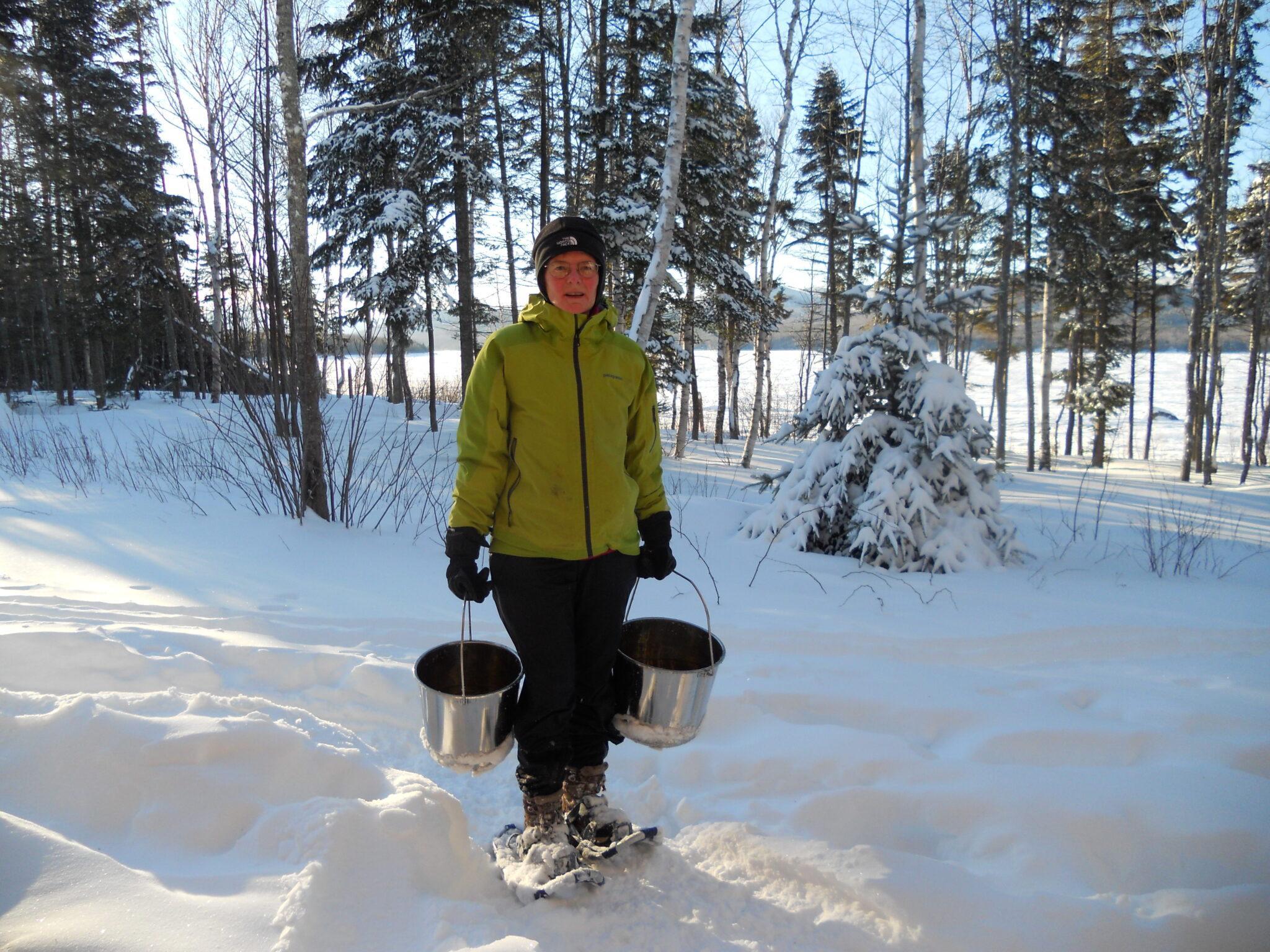
I’ve given a lot of thought to the arrangement of the kitchen area of my cabin. Let me give you a tour …

My pails sit next to my propane cookstove.

When my water supply runs low, I typically make three trips to the pump. After the first trip, I fill the water urn by my sink, the large pot on my stovetop (the burners’ pilot lights warm the water a bit), and I get started on my teakettle. After the second trip, I finish filling the teakettle, maybe fill a smaller pot, top off anything that’s not quite full, then use what’s left in the smaller pail to fill the larger pail to its brim. On my third trip, I refill the smaller pail. This amount of water will last a day to a day and a half, unless I do dishes or laundry.

My urn with its simple tap is one of my favorite cabin conveniences. It gives me a semblance of running water. And yes, that’s a conventional faucet behind the urn. The local craftsman who installed my slate countertop assumed I would have a water supply line connecting my pump to my cabin, at least in above-freezing weather, and he added the faucet as a bonus. Transporting water by this method would require electricity, so the faucet is purely ornamental for now.
In many backwoods cabins, the sink drain ceases to function when the temperature drops below freezing. In my case, my builder omitted the usual U-shaped under-the-counter pipe. Instead, water simply flows downward, into porous chambers buried in the ground just behind my cabin. Because it doesn’t trap any water, the drain pipe never freezes. The downside is that gas – which would be blocked by the water that would accumulate in a pipe bend – sometimes rises into the cabin from the chambers. Because they contain nothing worse than wastewater from washing myself or my dishes, I haven’t found odor to be a big issue. Carrying buckets of dirty water outside in subzero weather wouldn’t be much fun, so I’m willing to put up with occasional whiffs of decomposing food particles.

I sponge off my dirty dishes with diluted biodegradable soap, then set them in my large blue spatterware bowl, where I rinse them with water heated on the stovetop. I dip the water from my largest pot or pour it from my teakettle. This process takes a fair amount of water, and it consumes some of my limited supply of propane. I’ve learned that, when I’m alone, it’s more efficient to do a larger batch of dishes all at once, instead of washing them after each meal. So I stack used dishes neatly (or at least semi-neatly) to the left of the sink until the next washing session.
In a primitive cabin, laundry is a major project. To be honest, I save what I can for my trips to town, where I enjoy the decadence of an electric washer that’s connected to running water. But when I’m at my cabin for more than four weeks at a stretch, I need to wash some of my clothes by hand.
As I made my final preparations for winter, I picked up a canning vat, almost as an afterthought, thinking it would come in handy for laundry. I’m very glad I did.

I heat water in the large pot that sits on my stove, squirt some soap into the canning vat, add water, and put in my clothing. I use a large wooden spoon I bought at a local craft fair to stir the laundry in the soapy water. I wash a few pieces at a time, starting with the least soiled and moving on to dirtier items. When I take them from the water, I wring them out and set them aside for later rinsing. When everything has been through the soap solution, I carry the vat outside to dump the water; I have my doubts about pouring such a large volume down my sink.
Then I refill the vat with warm water and put clothes in to rinse, a few items at a time. The water soon gets sudsy with residual soap, and it takes about three changes of water before all is done. I run out of water partway through and need to put a pause on the laundry while I make the trek back to my pump.
I hang my rinsed and wrung-out clothing on a line that I string between metal loops on opposite sides of my cabin. At the end, I take a few moments to admire the scene with a sense of mingled relief and satisfaction.

During his famous stay in his cabin on Walden Pond, Thoreau’s mother helped him out by doing his laundry. This apparent lapse in self-sufficiency has subjected Thoreau to voluminous criticism. It’s extremely unlikely that my writing will have even a minute fraction of the impact of Thoreau’s work – but, just in case, here is the photographic evidence that will defend me from future critics.
Off the grid, doing just my own dishes and laundry requires considerable effort. The thought of caring for a brood of children in a frontier setting boggles my mind. I’ve been a big fan of Laura Ingalls Wilder’s “Little House” books since childhood. I’ve read them countless times and, in my elementary school days, acted out my fantasies of the Ingalls’ lifestyle in play. To the best of my recollection, none of those fantasies involved laundry. They certainly didn’t involve washing babies’ diapers by hand. I now have a much better understanding of Ma Ingalls’ stamina and work ethic.
Over the past two months, I’ve been saving questions that you, my readers, have sent me. In my next post, I plan to focus on answering some of them. If there’s anything you’d like to know about my life in the woods, please feel free to ask. If you received an email notification of this post, simply reply to it. Otherwise, you may reach me at wendy@wendyweiger.com.
And to those of you who will be celebrating over the next couple of days: I send my sincere wishes for a blessed Easter and a happy Pesach!
My book Living Every Season: A Mindful Year in the Maine Woods is now available for online ordering! Take a look: https://www.wendyweiger.com/photo-book/. It’s also for sale at several locations in Greenville, Maine: Northwoods Outfitters, the Corner Shop, Indian Hill Trading Post, and the Moosehead Historical Society. And in Monson, you’ll find it at the General Store. (Before making a trip, you may want to call ahead to be sure the shop where you’re headed hasn’t sold out.)
A note about a recent technical issue: Did you sign up for email notifications of new blog posts? Are you wondering why you’re not receiving them? During a website upgrade a few weeks ago, some subscription requests may have been lost. So if you found this post on Facebook, but failed to get the email notice you requested, please re-subscribe via the box on the right side of your screen at the top of this post. We sincerely apologize for the inconvenience.



